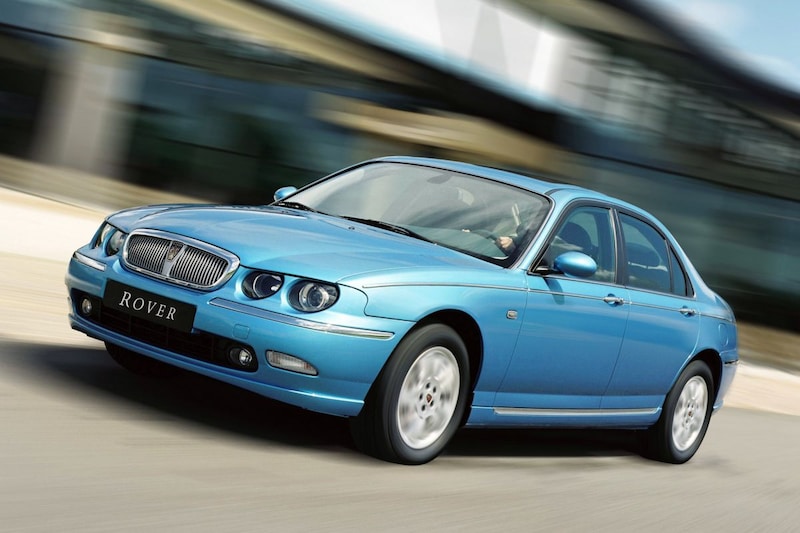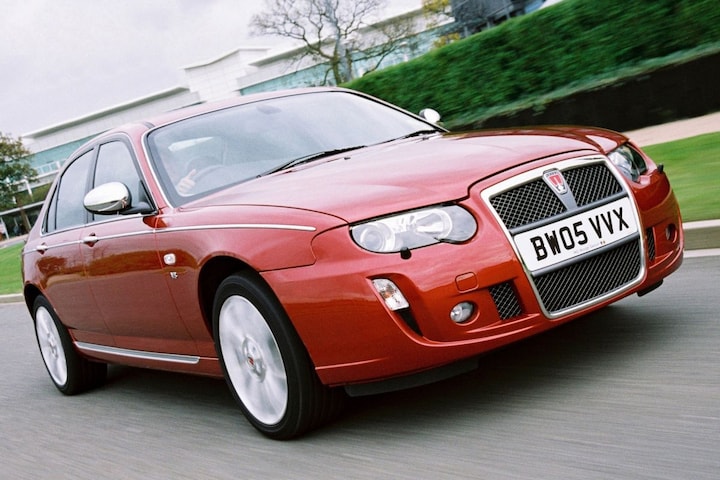Top year 1998

This year we regularly look back on the car year 1998. Icons such as the Ford Focus and the Audi TT have previously shone in the Top Year series. This episode is about the car that had everything it took to save a company from collapse: the Rover 75. But unfortunately, the mess was much too big and it became the last new Rover.
What was the start-up process of the Rover 75 like?
In 1993 Rover became part of British Aerospace. That year, the world was introduced to the Honda Accord-based Rover 600, the facelifted 800 and the sleek 200 and 400, from now on all cars with lines based on traditional Rover character, including a distinctive Rover grille. That’s for the outside world. Behind the scenes, Project Isis is underway, an attempt to break away from the Japanese partner. The project consists of three completely new cars: a successor to the 600 (referred to as Core), a successor to the 800 (referred to as Flag or Flagship) and an MPV-like (referred to as Erik). The clay modelers had barely finished the first scale models when BMW became the new owner of Rover in early 1994. Bavaria shoots Core and Erik. Rover has to focus on the large Flagship, which quickly leads to a design study with underlying technology from the BMW 5-series. The Germans are impressed, but whether it is for fear of cannibalism or not, Rover is ordered to concentrate on front-wheel drive. The Flagship model continues as RD1 and must now replace both the 600 and the 800. Somewhere along the way, the project name RD1 changes to R40. In the meantime, the engineers are given free rein to make the best of it. However, Munich does make adjustments towards the end of development to give the car a character that is distinctive enough compared to the BMWs.

Rover 75 design sketches that impressed BMW.
How was the 75 received?
The initial plan is to debut the 75 at the Geneva Motor Show in March 1999. However, to take the wind out of Jaguar’s sails, the 75 made its public debut in October 1998 at the Birmingham Motor Show. Jaguar presents the S-type there, which should attract 5-series drivers from BMW. However, most attention is not focused on the 75 (or the S-type) but on the BMW management, who use the event to make it clear that they are completely done with the bottomless pit that is Rover. Unlike the S-type, the 75 is far from ready. It wasn’t until the summer of 1999 that we were able to take it on the road for the first time. As AutoWeek, we initially had some difficulty in classifying the Rover 75 in the right place. Next to an Audi A6 and a Saab 9-5, it comes up just a little short with its somewhat limited space in the back. Compared to an A4 and a 9-3, the Rover is considerably larger. After the first test, our conclusion is clear: the 75 is a good car, we even think its driving behavior is ‘patent’. We also appreciate its appearance, but we think the interior is a colorful carnival.

How revolutionary was the Rover 75?
A transversely mounted engine that drives the front wheels is something new for BMW. Certainly not for the rest of the world, it is also a proven concept for Rover. In fact, in an earlier incarnation (BMC with Austin and Morris) the company was even more pioneering of the principle with the Mini. In 1998, Rover got rid of rear-wheel drives for a while, the SD1 was the last in 1986. With front-wheel drive sedans such as the 200, the 800, the 400 and the 600, we at Rover actually no longer knew any better. All the knowledge and expertise from decades of front-wheel drive must come together in the 75. In favor of McPherson struts, the double triangular wishbone construction always promoted by Honda is left behind at the front. At BMW they are fine with it. They also use that solution themselves. But the rear axle construction initially devised is not entirely to the Germans’ liking. The proposal from Munich is to use a solution comparable to what BMW itself once applied to the Z1. And with success. For years, the 75 has been regarded as the best front-wheel drive car that BMW has never built. After Rover’s bankruptcy in 2005, SAIC continued to produce the car in China as the Roewe 750, including a self-developed hybrid powertrain. They also use the platform for other Roewe and MG models, they are so satisfied with the basic concept.

What were the choices during the market introduction?
In 1999, as a Dutch 75 buyer you could choose from three equipment levels: the basic model without designation, the Club and the Sterling. Right from the start we see three petrol engines and one diesel engine in the price list. The 116-hp diesel is a two-liter four-cylinder common rail turbo engine from BMW, a first cousin of the power source in the BMW 320d, but turned a quarter turn and slightly reduced in performance. The lightest petrol engine is also a four-cylinder: the 1.8-liter version of the K engine. There are also two V6s, a 2.0 and a 2.5 liter with 150 and 177 hp respectively. With the latter you always have an automatic transmission, with the other engines the automatic is an option. In the first year, the 2.5 was always generously decorated as a Sterling and the other engines were dressed a little more modestly.

How was the 75 received by consumers?
Rover is not exactly mainstream, and for some the reputation of English cars is a reason to stay away from the brand. Furthermore, its retro appearance does not appeal to everyone. Yet the 75 manages to claim a share of the market. It sells significantly better than, for example, the Lexus IS or the Lancia Lybra. And he also keeps the Jaguars X-type and S-type behind him in the sales statistics. Saabs, on the other hand, sell a lot better, not to mention Audis, BMWs and Mercedes.
The diesel is doing well among business drivers. When we look at the reviews that 75 drivers gave on AutoWeek.nl at the beginning of the century, the vast majority appear to be very satisfied. If there are any complaints, they are minor inconveniences, such as the automatic volume control of the audio system or a creaking ventilation grille in the dashboard, it should not be named. Riders everywhere praise the chassis, as well as the seating comfort, ease of operation and drive technology.

Which version appeals most to the imagination?
If you like a challenge, go for a four-cylinder petrol engine. Rover’s K engine quickly turns out to be a problem, not so much because of its modest power. No, the power source suffers from HGF. This stands for Head Gasket Failure in English. If it leaks, the cooling water flows into the lubrication circuit, which does not improve lubrication and causes the engine to overheat. The problem can be solved, but it will take a few days of work and you shouldn’t be afraid of black hands.
If you are looking for more sensation, then you should have the 75 V8. Under the hood you will find the 4.6-liter V8 from the Ford Mustang. For this exotic car, Rover has completely overhauled half the car: the 260-hp machine is positioned lengthwise, just like in the Ford, and drives the rear wheels. The whole operation turns the already well-driving 75 (or MG ZT) into a fun attraction. Not even because of its performance – 260 hp is not an extreme value – but thanks to its very pleasant driving characteristics and its beautiful full sound. If you are really looking for something special (or actually there is no point in searching, you have to come across it) then there is the 75 with an extended wheelbase, which gives the rear passengers 20 cm more legroom.
What were the Rover 75’s competitors?
The 75 is not easy to categorize. Because it has to replace both the 600 and the 800, it is a bit between a napkin and a tablecloth: for a D-segment sedan it is a big boy and for a real E-segmenter it falls slightly short. It rises just above the drab mediocrity without immediately becoming premium. In any case, he is not mainstream. That placed it in the corner where potential buyers look at, for example, a Saab 9-3 or 9-5, but also at the Lancia Lybra, the Lexuses IS and GS and the Volvo S60. And don’t forget its fellow countrymen: the Jaguars X- and S-type.

Any details during his life?
The 75 will initially be built in Cowley (Oxford). When BMW sells Rover, the Germans keep Cowley for the production of the new Mini. Production of the 75 will therefore move to Longbridge. The quality does not directly suffer from this, Rover continuously implements product improvements. But in order to reduce costs, the MG Rover management also pulls out all the stops, which means that towards the end the 75 is assembled with increasingly poor materials, including the use of poor plastics that no longer even give the appearance that it is should have been wood.

After BMW sold Rover, the Tourer, the practical station wagon, appeared. It was developed under BMW direction and is already waiting in the wings. Furthermore, an MG version of the 75 will be released, just like the 25 and 45. In the case of the 75 it is called MG ZT. Under BMW leadership, a dynamic variant is unthinkable for fear of internal competition with the 3-series. With the MG Z series, Rover engineers show what they can do, but also what the potential of the R40 is.

Rover 75 from after the facelift and also the mighty (we wouldn’t dare say muddy with the chic brand) V8.
In reality, those MGs are a desperate attempt to milk the Rover models as much as possible. In addition, it is a way to keep up appearances to potential partners and investors: ‘We are not dull and tired, but full of energy, things are going at a crescendo here’. To show the potential of the 75, a variant with a longer wheelbase, a coupe concept car, is even being released and behind the scenes the engineers are even working on a Rover 75 with four-wheel drive.


What has been the impact of the Rover 75?
The design of the RD1 is a nod to the Rover P4 and P5 of yesteryear, although according to the Rover people it is not about ‘retro’, but about the appearance of the craftsmanship of that time. Perhaps it is also a desire for nostalgia, a break with the sharp-lined Rovers of the Honda era. In any case, the 75, together with the Jaguar S-type, gives an important boost to the retro design trend.
How many were built and how many are left?
The 75 is unable to match the sales successes of the 600, that bastard Accord was very popular among lease-driving Dutch people at the end of the last century. Taking all sedans and station wagons together, 211,175 Rover 75s and 27,149 MG ZTs were built, giving a total of 238,324 units. That is the English production, initially in Cowley and later Longbridge. How many Roewe 750s and MG 750s were assembled by SAIC in Yizheng, China between 2006 and 2016 is unknown, just as we do not know how many MG 750s SAIC exported to Peru, Chile and Egypt, among others. At the time, 5,577 Rover 75s and 227 MG ZTs were registered in the Netherlands. According to data from Vinacles, approximately 1,100 copies remain.

– Thanks for information from Autoweek.nl